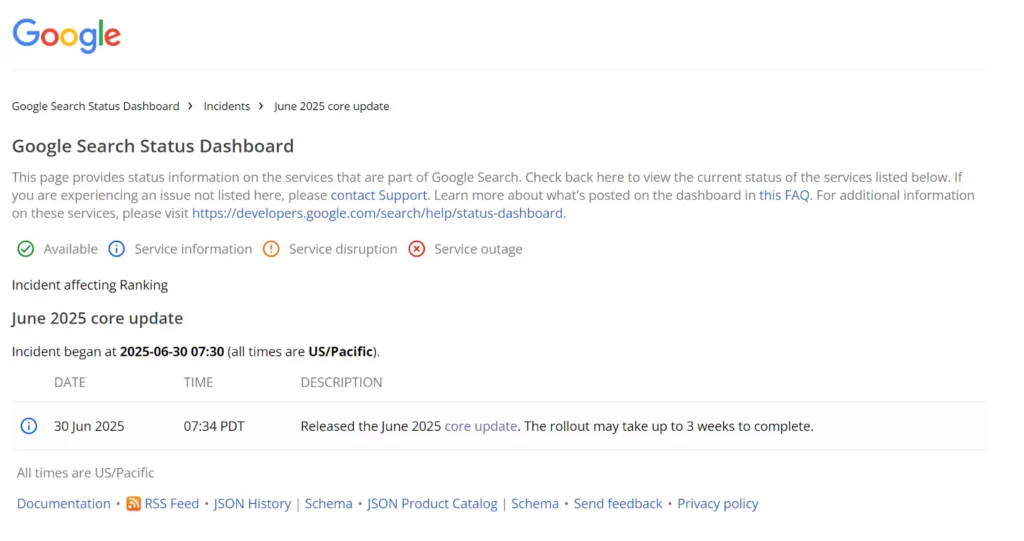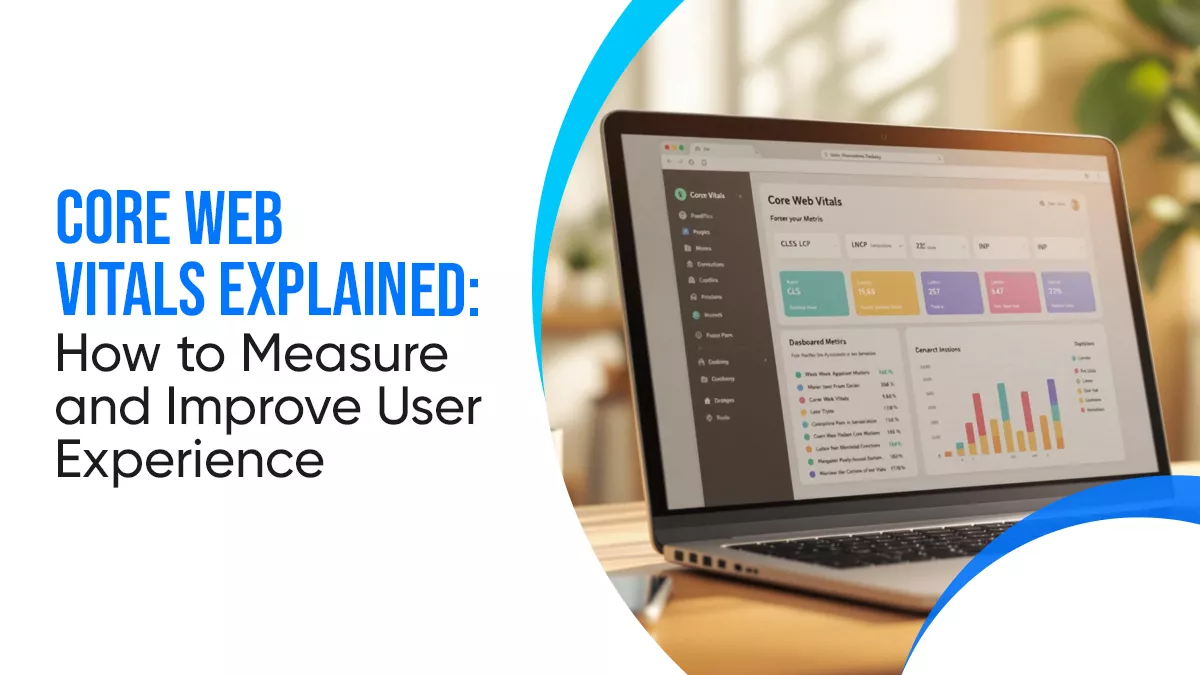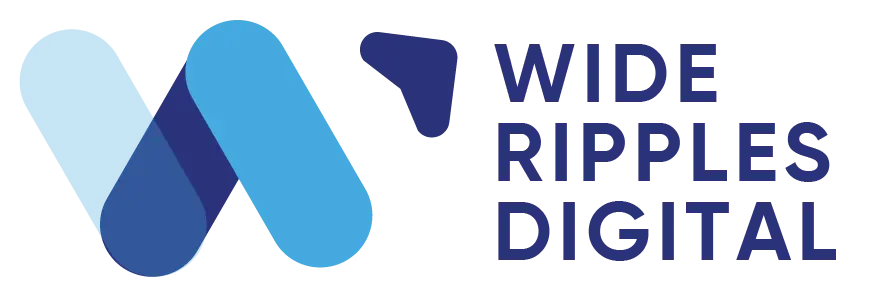On June 30th, 2025, Google announced the rollout of their June 2025 Core Update, a broad algorithm change affecting various aspects of search rankings.
This update is the first since the March 2025 Core Update and the second core update of the year.
The June 2025 Core Update is already causing changes in ranking across multiple industries, as Google adjusts its ranking systems. If you wish to know whether you will be affected or now continue reading..
What Is a Core Update?
A Core Update is a big change in how Google ranks websites. These updates help Google better decide which pages are the most useful and relevant in search results. Unlike updates that target specific SEO tricks or punish websites, core updates change the way Google ranks pages to show the best content for users.
The main goal of a core update is to make search results better by helping people find trustworthy and accurate information. Because of this, some websites may move up in rankings, while others might go down. These changes don’t mean the content is bad, but that other pages are now seen as a better match for what people are looking for.
The June 2025 Core Update is Rolling Out
As with previous core updates, Google has not shared detailed specifics about the June 2025 Core Update. However, based on previous updates, it is likely focused on enhancing how Google assesses and ranks content in search results.
Google’s increasing reliance on AI Overviews and its new AI Mode may also result in changes to how AIO answers are presented and how content is cited in search results.

How Long Will the Rollout Take?
Typically, core updates take about two weeks to fully roll out. Google has indicated that this will be the case with the June 2025 Core Update, but this timeline can sometimes extend to 4 to 6 weeks, especially for more complex updates.
As with any core update, we will need to be patient and observe how the rollout unfolds.
Recent Ranking Volatility
In the week before the June 2025 Core Update, there have been some changes in rankings across different industries. This shows that the update is starting to take effect.
According to Semrush’s Sensor tool, the level of change is moderate, with a score of about 5 out of 10. This means that while there are changes, they aren’t too big or worrying yet.
However, since the update is still rolling out, we can expect more ups and downs in rankings over the next few weeks. It’s also important to remember that ranking changes don’t usually stop right after the update finishes.
It can take a few weeks for the search results to settle and for the full effects of the update to be seen. So brace yourself, Winter is coming.
If you see drops or gains in your rankings, it’s best to wait until the update is fully rolled out before making big changes to your website. Updates like this often cause short-term changes that will smooth out over time.
How Will the Core Update Affect My Website?
If the June 2025 Core Update impacts your site, you may notice changes in your rankings, which could affect your traffic, leads, and sales.
A drop in rankings doesn’t mean you’ve done anything wrong; it just means that Google’s algorithm may now favor content that is more comprehensive, better structured, or demonstrates clearer authority. You can always consult experts in SEO and Content Strategy.
If you’ve been actively improving your content quality, enhancing internal links, or updating your site, you might see a positive shift in your rankings.
Some areas showing early impact from the June 2025 Core Update include:
- High-value commercial keywords
- Featured snippets and People Also Ask sections
- Local map packs and review-based searches
If your website has been affected, it’s crucial not to make quick changes. It’s better to monitor the situation, assess the performance, and allow the update to fully roll out before deciding on any major adjustments to your SEO strategy.
Key Metrics to Monitor
As the June 2025 Core Update unfolds, here are the tools and metrics you should keep an eye on:
- Google Search Console: This tool will help you track any changes in organic impressions, clicks, and your site’s average position. Pay special attention to your top-performing pages. A drop in visibility could indicate the update’s impact. Also, check your Index Coverage and Page Experience reports for potential crawl errors or issues.
- Google Analytics: Review your organic traffic trends, especially comparing the last 7 to 14 days with the previous period. A drop in traffic from Google may signal a decrease in rankings. Additionally, look at metrics like bounce rates, time spent on site, and conversions to gauge the quality of user engagement.
- Keyword Positioning: Tools like Semrush and Ahrefs can help track changes in keyword positioning and site visibility. If you notice competitors gaining ground, compare their content structure and topic coverage against yours to identify areas for improvement.
- Manual SERP Checks: Conducting manual searches for keywords where you previously ranked for featured snippets, image packs, or local results can help you see if your content is still performing well.
Recovery Tips If Your Website Is Impacted
If your site has been negatively affected by the update, here are a few steps to recover:
- Review Google’s Content Guidelines: Make sure your content aligns with Google’s standards for quality and expertise. Ask yourself if your content genuinely helps users or if it’s just optimized for search engines.
- Focus on Helpful Content: Google values content that is clear, actionable, and tailored to user intent. Avoid keyword stuffing and vague explanations. Ensure your content directly addresses what users are searching for.
- Improve E-E-A-T Signals: For industries like finance, health, or legal services, ensuring your content reflects Experience, Expertise, Authoritativeness, and Trustworthiness (E-E-A-T) is critical. Highlight author qualifications, link to credible sources, and keep your content up to date.
- Strengthen Internal Linking: A solid internal linking structure helps Google understand your site better and improves user engagement. Link related content together and use descriptive anchor text.
- Update or Repurpose Old Content: Refresh older content with updated examples, statistics, and clearer formatting. Combining smaller, related pieces of content into a more comprehensive page can also help improve rankings.
- Consolidate Thin Pages: If you have short, low-quality pages, consider merging or removing them to improve your site’s content quality.
Conclusion
The June 2025 Core Update brings important changes to how Google ranks websites. While it might cause some changes in rankings at first, the most important thing is to focus on creating high-quality, helpful content. Google wants to show users the best and most trustworthy information, so websites that offer this kind of content are more likely to do well.
If your website is affected by this update, don’t worry. Take the time to improve your content and make sure it’s helpful for your audience. Instead of making quick changes, give the update some time to fully roll out before changing your SEO strategy.
Keep an eye on the changes and follow best practices to improve your website. By doing this, you can adjust to the update and make your website stronger in search results.
Quick FAQs About The Google Core Update 2025
What is Google’s June 2025 Core Update?
The Google June 2025 Core Update is a significant change to Google’s search ranking algorithm. It adjusts how Google ranks and evaluates content in its search results.
When did the June 2025 core update begin and end?
The June 2025 Core Update started on June 30th, 2025. While the full rollout typically takes about two weeks, it may take longer to complete in some cases.
What changes does the June 2025 core update include?
This update focuses on refining how Google assesses content for relevance and quality. It aims to improve search results by rewarding high-quality, user-friendly content. There may also be improvements in AI Overviews and content citation.
How long will the June core update rollout take?
The rollout of the June 2025 Core Update is expected to take about two weeks. However, this can vary depending on the complexity of the update, sometimes extending to 4-6 weeks.
Will the June 2025 update affect my site’s search rankings?
Yes, the update could impact your website’s rankings. Some pages may improve in rankings, while others may experience drops, depending on the quality of content and how well it aligns with Google’s updated ranking criteria.
How can I recover if negatively impacted by the core update?
If your site is negatively impacted, focus on improving content quality. Ensure your content is helpful, informative, and aligns with E-E-A-T (Experience, Expertise, Authoritativeness, and Trustworthiness). Be patient and allow time for the algorithm to settle before making any drastic changes.
Does Google offer specific actions for core update recovery?
Google does not provide specific actions for recovery after a core update. However, they emphasize improving content quality and following their guidelines around E-E-A-T and user-first content.
What Google tools can detect the core update impact?
You can use Google Search Console to track changes in organic impressions, clicks, and rankings. Google Analytics can help you monitor traffic trends, and tools like Semrush and Ahrefs can track keyword rankings.
How are AI Overviews and search volatility related to the core update?
AI Overviews and search volatility are linked to how Google uses AI in its ranking systems. The June 2025 Core Update may improve AI Overviews, affecting how answers and content are presented in search results, leading to some fluctuations in search rankings.
Will UX or page speed be a focus of the June 2025 update?
While UX and page speed are always important for ranking, this core update is more focused on content quality and E-E-A-T signals. However, these factors still play a role in overall site performance.
Is this the second core update of 2025?
Yes, the June 2025 Core Update is the second core update of the year, following the March 2025 Core Update.
How does this update compare to the March 2025 core update?
The June 2025 Core Update is similar to the March 2025 Core Update in that both focus on improving how Google evaluates content. However, the June update may place a stronger emphasis on AI-related features and content relevance.
What is E-E-A-T, and why does it matter in core updates?
E-E-A-T stands for Experience, Expertise, Authoritativeness, and Trustworthiness. These factors help Google determine the quality of content. Websites that demonstrate strong E-E-A-T signals are more likely to rank higher, especially after core updates.
How should Canadians adjust SEO strategies after the June update?
Canadians should focus on creating high-quality, user-focused content that aligns with E-E-A-T principles. Local SEO practices, like targeting regional keywords and improving local listings, can also help maintain or improve rankings.
What industries are most impacted by the June core update?
Industries that heavily rely on trust and expertise, such as healthcare, finance, law, and news, are likely to see more significant impacts. Websites that show clear authority and expertise in these fields will benefit more from this update.
Disclaimer: The information provided in this blog is for general informational purposes only. For professional assistance and advice, please contact experts.








